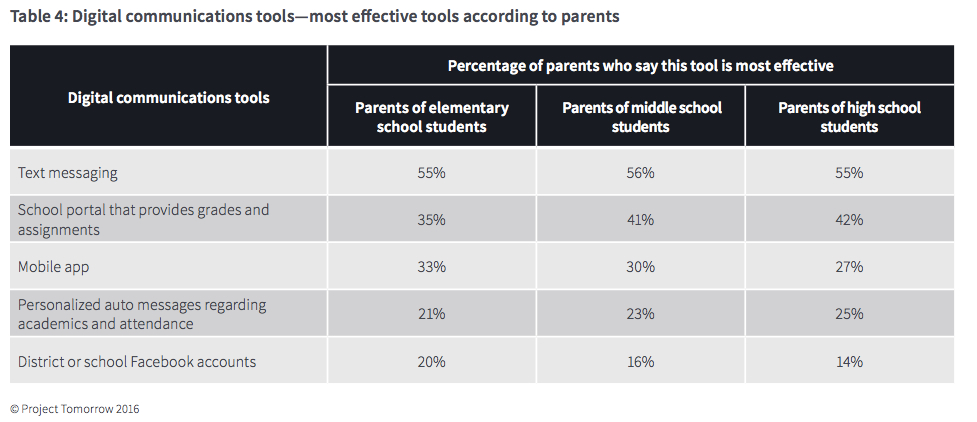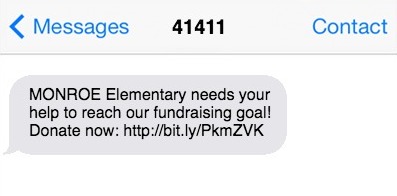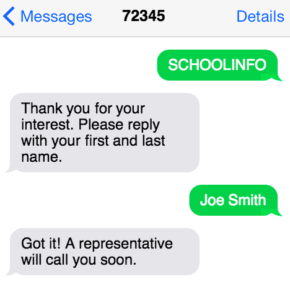15 Ways K-12 Schools Can Use Text Messaging To Improve School Communications
Improving school communications is a priority for many K-12 districts. How do schools engage with families, students and their communities? How do schools foster positive relationships and increase parent participation? The challenge many districts face is figuring out which school communications tools to use.

Text Messaging Most Effective
According to a recent report from Blackboard and Project Tomorrow, over half (55%) of parents surveyed said text messaging was the most effective digital communication tool (a big jump from 5% of parents surveyed in 2010). A little less than a third of parents thought mobile apps were most effective, and 14-20% of parents felt that the school or district’s Facebook accounts met their needs.

Table from Blackboard/Project Tomorrow Report: Trends in Digital Communications 2016
Why Text Messaging for School Communications?
Today’s families are incredibly busy. Many families have both parents working outside the home and are increasingly over-scheduled. Nine out of ten American adults have a mobile device in their hand or within reach at all times of the day (and night!). Pushing the most important information they need to know through text message is preferable to the alternatives: parents searching for the information in an email newsletter, Facebook post or school meeting.
Another challenge mentioned by 54% of district communication officers was parents ‘ lack of reliable internet access. While most families today do have Internet access, either through a home computer or smartphone, many low and moderate income families remain “under-connected.” Slow Internet connections, lack of coverage, or service cutoffs due to cost are all factors limiting Internet access. Text messaging does not require Internet access and SMS messages can be sent to almost anyone with a cell phone.
Reaching Your School Community by Text Messaging
Text messaging can be integrated into a school’s communication strategy in a number of ways:
- Severe Weather and School Emergency Alerts. Let everyone know when school will be closed because of a snow storm or alert parents when your campus is locked-down for safety concerns.
- Time Sensitive Reminders. The most effective use of text messaging is for time sensitive issues such as deadlines to fill out registration forms, event cancellations or important meeting invites.
- Fundraising Drives. Cash-strapped schools rely on fundraising to help pay for things like school enrichment programs, field trips and computer labs. Send out mass text messages with link to your latest fundraising campaign or donation page, or add a text call-to-action asking parents to text a keyword and receive a link to your page. Or, set up a text program that allows you to track bidders at your next school auction!

- Surveys. Want to know what parents’ top issues are? Ask them to text a keyword to receive a text autoreply with link to short survey at Back to School night this year.
- Class Supply List. Parents shopping for school supplies may forget to take their class supply list with them. Make it easy for them by distributing the list by text message.
- Lunch Menus. What’s for lunch? Parents and students can easily check the cafeteria menu each day by texting a keyword to an easy-to-remember short code like 73245.
- Student Communications. Middle and high school students may not check their emails very often, but they won’t ignore the ding of a text message. Send class information, updates from student clubs and sports teams or general reminders.
- Staff Updates. Parents and students aren’t the only ones that need to be on the same page. Use text messaging to remind staff about important meetings and due dates.
- PTA and Volunteer Communications. Use text messaging to get families to sign up and volunteer at the next bake sale or for campus beautification projects. Collect names and phone numbers through TextMarks platform or use SMS to drive parents to a volunteer management site..
- Anti-Bullying Efforts. Make schools safer by giving students the tools they need to report bullying on campus. Set up a text program that allows kids to notify you when an incident occurs.
- Recruitment. If your school requires marketing to prospective families, text messaging can be used to recruit. Distribute links to your school’s information page or collect leads for your recruiters to follow up on.

- Attendance Check-ins. Instead of paper sign up sheets or roll call, use SMS for attendance and allow students to check in and acknowledge their presence.
- Community Updates. Parents and teachers aren’t the only stakeholders involved when it comes to school communications. Send texts to inform the community about key education issues.
- Educational Tips. Sending regular texts to nudge parents can help increase parental involvement at home and school. Send factoids, tips or exercises parents can do with their kids at home and see significant improvement in scores for those that receive messages vs. those that don’t.
- Encourage sign-ups for other school communication channels. Not all school communication is right for text messaging. But you can use text to drive more sign-ups of your school’s email newsletter or promote your social media channels.
Interested in learning more about using text messaging for schools? Contact TextMarks at 800-696-1393 or email tmsales@textmarks.com.
















